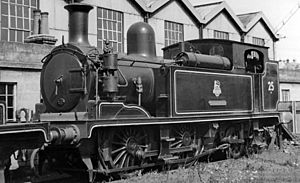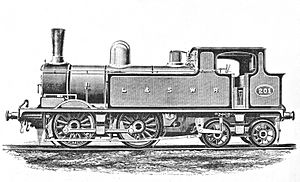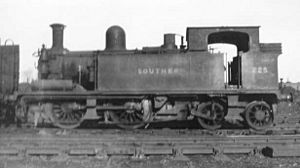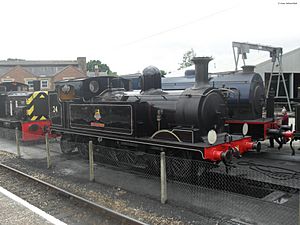LSWR O2 class facts for kids
Quick facts for kids LSWR/SR O2 |
|
 |
|
| Number W25 Godshill at Ryde St John's Road loco shed | |
| Power type | Steam |
|---|---|
| Designer | William Adams |
| Builder | LSWR Nine Elms Works |
| Build date | 1889–1896 |
| Total production | 60 |
| Configuration | 0-4-4T |
| UIC classification | B2′ n2t |
| Gauge | 4 ft 8 1⁄2 in (1,435 mm) standard gauge |
| Driver diameter | 58 in (1.473 m) |
| Trailing wheel diameter | 37 in (0.940 m) |
| Length | 30 ft 8.5 in (9.360 m) |
| Locomotive weight | 48.40 long tons (49.18 t; 54.21 short tons) |
| Fuel type | Coal |
| Fuel capacity | 1.50 long tons (1.52 t; 1.68 short tons); later 3.25 long tons (3.30 t; 3.64 short tons) |
| Water capacity | 800 imp gal (3,600 L; 960 US gal) |
| Boiler pressure | 160 psi (1.10 MPa) |
| Cylinders | Two, inside |
| Cylinder size | 17+1⁄2 in × 24 in (444 mm × 610 mm) |
| Tractive effort | 17,235 lbf (76.67 kN) |
| Power class | Isle of Wight: B BR: 0P |
| Locale | Great Britain |
| Withdrawn | 1955 – 1967 |
| Disposition | One preserved, remainder scrapped |
The LSWR O2 Class is a type of steam locomotive built for the London and South Western Railway (LSWR). These powerful engines were designed by William Adams. Sixty of these locomotives were made between 1889 and 1896. They were the very last steam trains to run on the Isle of Wight. The final two were taken out of service in 1967.
Contents
Why the O2 Class Was Built
In the 1880s, more and more people were moving to the areas around London. This meant many more people needed to travel by train every day. The LSWR needed new trains that could handle all this extra passenger traffic. They needed engines that were strong but also small enough to fit on busy city tracks. They also needed to be able to speed up quickly for frequent stops.
William Adams decided on a special design called the 0-4-4T. This design helped the O2 Class locomotives be powerful and compact. It also allowed them to accelerate well for busy commuter routes.
Building the O2 Class Locomotives
The O2 Class was an improved version of an earlier train design by William Adams. These new locomotives were made to be useful for many different types of train jobs. They had smaller wheels and cylinders, which made them compact. This small size meant they could travel on many different railway lines.
Building of these locomotives started in 1889. The first 20 were built at the LSWR's Nine Elms works. Because they were so successful, 30 more were ordered the next year. The last ten were finished by 1895.
| Order | Year | Quantity | LSWR numbers |
|---|---|---|---|
| O2 | 1889 | 10 | 177–186 |
| B3 | 1890 | 10 | 187–196 |
| K3 | 1891 | 10 | 197–206 |
| D4 | 1891 | 20 | 207–226 |
| R6 | 1894 | 10 | 227–236 |
Life on the Mainland Railways
LSWR Days: 1889–1922
At first, the O2 Class trains were used a lot for short trips around London. But by 1897, newer, more powerful trains were introduced. This meant the O2s were then used for lighter jobs. They were sent to different parts of the LSWR railway system. Their small size and light weight made them perfect for smaller branch lines.
Southern Railway Days: 1923–1948
All the O2 locomotives were still in use when the Southern Railway took over in 1923. They kept working across the old LSWR lines. However, as more railway lines became electric, and newer trains were built, some O2s were no longer needed. This allowed the Southern Railway to send some of them to the Isle of Wight. Some mainland O2s were taken out of service, with eight in the 1930s and four more in the 1940s.
British Railways Days: 1948–1967
Even with some being taken out of service early, many O2s continued to work for British Railways. They worked on various branch lines until these lines started to close in the late 1950s and early 1960s. The last O2 on the mainland, number 30225, was taken out of service in 1962.
The Isle of Wight Connection
The O2 Class trains are most famous for their work on the Isle of Wight railway system. In 1923, the Southern Railway needed to solve a big problem with train power on the island.
The solution came when newer, more powerful trains replaced the O2s on the mainland. This meant there were spare O2 engines available. Two of these trains were changed to work with the Isle of Wight's passenger cars. They were then shipped across the Solent (the sea channel) in 1923. These trains worked very well, especially on the busy Ryde–Ventnor route. More O2 trains were sent to the island in batches during the 1920s and 1930s.
The final two O2s arrived on the island in 1949, bringing the total to 23 locomotives. Their compact size, light weight, and good power made them perfect for the island's railway lines. From 1932, a larger coal storage area was added to the island locomotives. This helped them carry enough fuel for their journeys. They could pull trains with up to six passenger cars on all the island lines.
After 1960, the O2s were the only type of locomotive left on the island. They continued to run until steam train services ended on the island. An O2 train operated the very last steam train on December 31, 1966.
Two O2s, named W24 Calbourne and W31 Chale, were kept to help with engineering work. They were used during the electrification of the Ryde–Shanklin line. Both were taken out of service in March 1967 once the electric line was finished.
How They Looked: Colours and Names
LSWR Colours
When they were first built, the O2s were painted in a yellow-brown colour. They had the letters 'LSW' on the side of their water tanks. Later, they were painted in a sage green colour with black and white lines. Their numbers and the 'LSWR' letters were in gold.
Only one O2 train on the mainland ever had a name: Number 185 was called Alexandra for a short time.
Southern Railway Colours
During the Southern Railway era, the O2s were painted in olive green with lines. Later, they changed to a bright green colour with "Sunshine" lettering.
The Southern Railway kept the original LSWR numbers for the mainland trains. Trains on the Isle of Wight were given new numbers starting with "W". They were also named after places on the island.
British Railways Colours
When British Railways took over, the O2s first kept their Southern Railway colours but with 'British Railways' added. Soon after, they were painted in a standard black colour with red and white lines.
The Isle of Wight trains kept their "W" numbers and names. The mainland trains had 30000 added to their old Southern Railway numbers.
Preservation
Two of the Isle of Wight locomotives were saved from being scrapped. These were the ones used for engineering work. Sadly, the attempt to save W31 Chale did not work, and it was scrapped in 1967.
However, W24 Calbourne was bought by the Wight Locomotive Society. This group later became the Isle of Wight Steam Railway. Calbourne was fixed up and started running again in 1992. It had another major check-up in 2010. Today, it pulls tourist trains between Smallbrook Junction and Wootton. A new overhaul began in 2019 and was finished in 2021. This was just in time for the locomotive's 130th birthday and the railway's 50th anniversary!
Calbourne is the only O2 locomotive that still exists. All the other trains of this type were scrapped.
Images for kids








